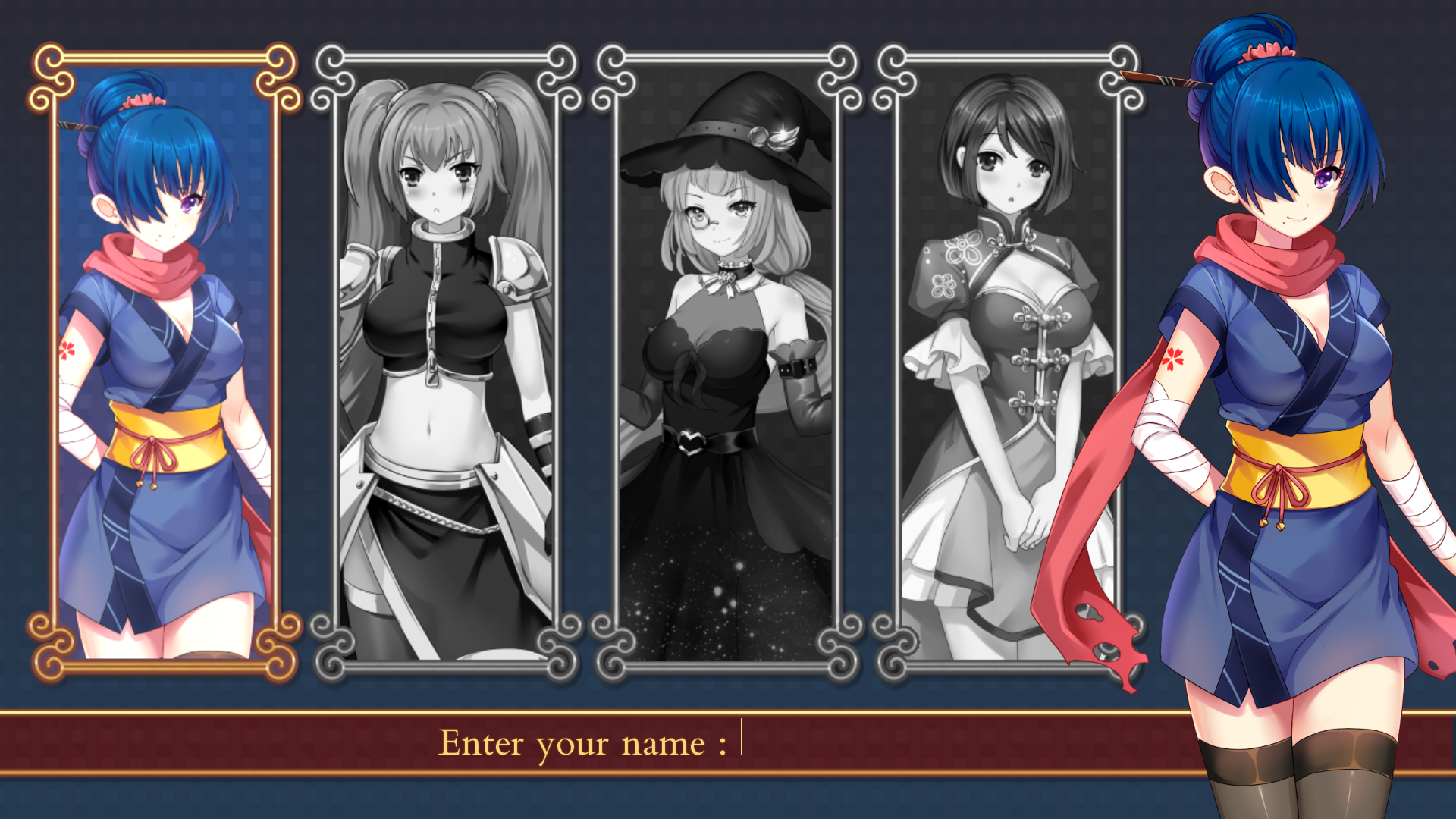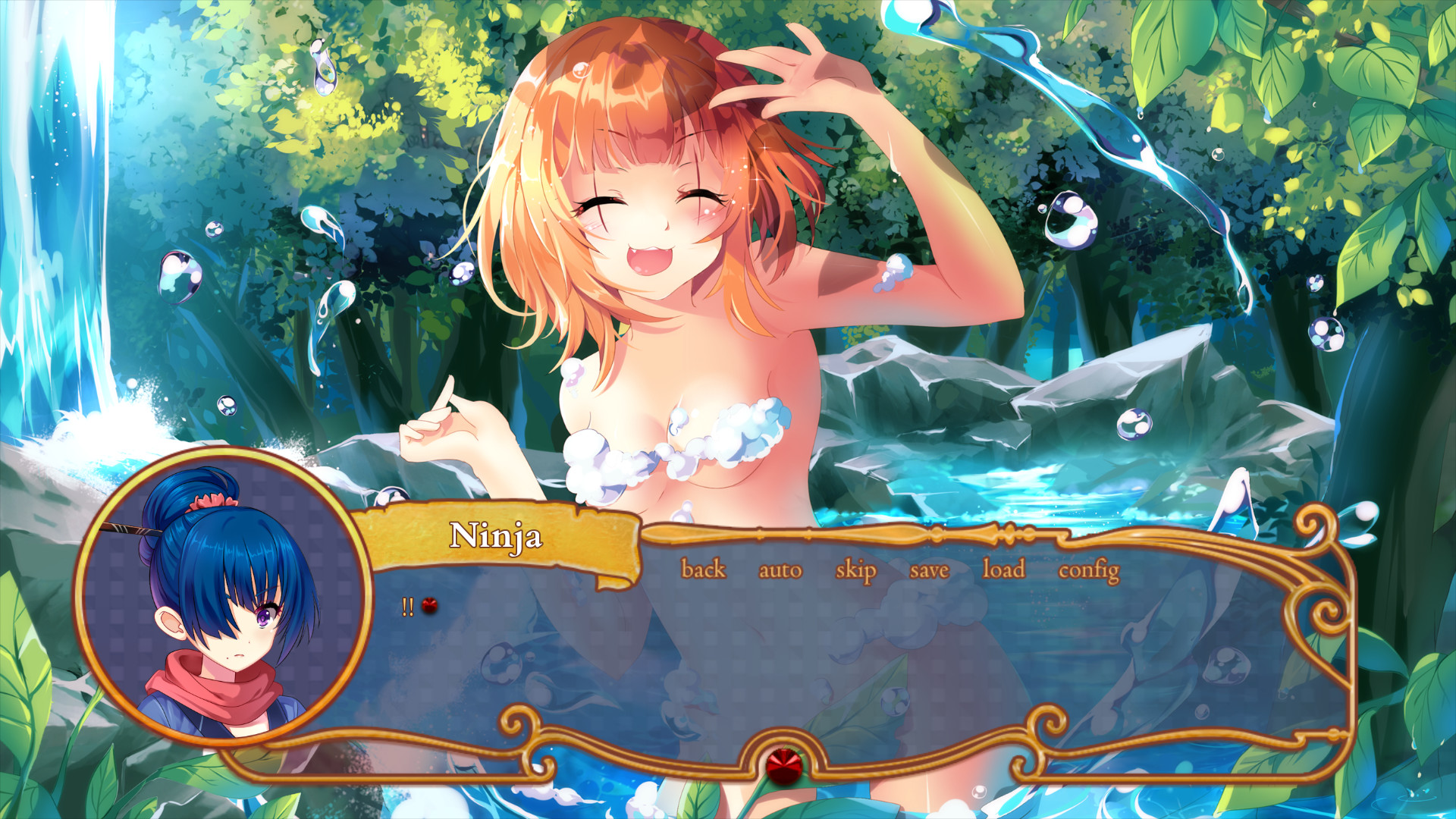
EVN releases often come apparently out of nowhere, with games either flying under the radar during their entire development process or simply being forgotten due to delays and inconsistent promotional efforts on the part of their authors. This lack of proper buildup can easily spell a commercial disaster for such titles, especially considering today’s overcrowded indie market and the Steam storefront so full of shovelware that browsing recent releases stopped having any functional meaning. Thankfully, at least some of these games can still break out of total obscurity thanks to their particular merits, or even having the help of someone with a particularly big megaphone (which, in the realities of the VN market, means one of the very few established publishers interested in Japanese-styled games).
One of the recent titles that apparently got away with its extremely-prolonged development and a long period of obscurity is Serment – Contract with a Devil. This lighthearted, yuri themed dungeon crawler by Nkt Studio was released on Steam by Sekai Project in early February 2019, nearly three years since the reveal of the first demo and after significant changes to the game, including a drastic visual makeover. Thanks to its beautiful promotional art, appealing premise and the developers quickly responding to players’ feedback, it managed to gather a decent amount of attention and positive response. But what exactly this “dungeon crawler/visual novel hybrid” has to offer?

The class choice makes a significant difference, both narratively and when it goes to playstyle, but the repetitive dungeon crawling makes it hard to justify multiple playthroughs
Serment in its base premise seems to be rather openly inspired by Recettear: An Item Shop’s Tale, another anime-style indie game that received a lot of praise from both players and reviewers a few years ago (it's even directly referenced in Serment’s story). Recettear is a fantasy item shop manager combined with a dungeon crawler, in which the protagonist is forced to run a business in order to pay off her inherited debt, in progressively bigger and harder-to-match quotas. It’s a very tense game, in which you will most likely fail repeatedly until you get a very good grasp on the mechanics and truly optimize your playstyle. Serment starts with a simpler plot and mechanics, with the protagonist being an adventurer who died during one of her quests and was resurrected in the demon world by Lucifer – a particularly cute and friendly “devil”, who requests a repayment in gold for her services, paid in six, progressively bigger instalments. To fulfil the contract, our lead is forced to use her skills by exploring the local dungeon and doing quests for demon world’s surprisingly non-threatening inhabitants – all within a time limit, with payments at the end of every week and every action, be it travelling, interacting with other characters or fighting monsters, consuming precious time.
That was, at least, the initial setup, as reacting to players' complaints, developers quickly relaxed the pressure from recurrent payments, increasing gold earned in the dungeon and reducing the time required for various activities, as the highly-limited resources got in the way of exploring the game’s world and story. This was especially important for some side-events and quests, which can pretty much only be uncovered by trial-and-error, visiting various locations and dungeon floors at certain points of the story or with the right team composition. When every wasted hour threatens you with a game-over, casual exploration is not something you can do effectively. Apart from these side activities, which are identical in every playthrough, the game has a short main story for every one of the four playable characters, which progresses automatically after every payment to Lucifer and includes a pre-determined romance subplot. This structure leaves pretty much no place for the player agency in directing the game’s core story, but is consistent with the notion that every player class (the warrior, mage, ninja and freelancer) is not just a set of skills, but a proper character with unique personality and backstory. Their love interests are the ones that fit their characters the most, rather than ones of the player’s choosing.
What has to be said clearly at this point, however, is that both the core storylines and the optional interactions are neither particularly long nor very deep, adding to maybe four hours of story content in total. Everything is extremely cute and lighthearted, with little to no drama, dark story elements or fanservice, which people would expect from more “mature” anime RPGs. This translates even to the stylistics of the dungeon and monsters that inhabit it, with very few enemies that could be in any way described as “threatening” (which doesn’t mean they can’t wreck you if you’re careless or advance through the floors too quickly). A few fanservice CGs and end-game bonus costumes add a little bit of spiciness the experience, but nowhere close to what you’ll find in even censored versions of genuine “hRPGs” such as Sakura Dungeon – Serment’s aim is definitely to be lovely and relaxing, rather than sexy, and it does a reasonably good job at it.

The game offers some light fanservice, but most of the time stays firmly on the “safe & cute” side of yuri romance
When it goes to RPG mechanics, Serment is a good compromise between simplicity and customisation. There are six teammates that you can recruit throughout the game (with up to three characters actively taking part in combat), all with their own specialisations and unique perks, which along with the significantly-varied player classes allows for many fully-viable playstyles. There’s also a limited gear system, with the characters being able to equip a single weapon, armour and amulet at any given time, but most items offer unique bonuses and skills, along with significant stat trade-offs, giving a lot of space for meaningful changes to characters’ effectiveness and their roles within the team. The main barrier for switching between team compositions and tactics freely is the cist of stat upgrades, which cost gold and are separate for every character – this not only limits you by having to put away funds for weekly payments and other events, but punishes you heavily for splitting the investment beyond the characters you use the most. There are also risk-reward mechanics that reward you for summoning as few companions as possible, as the fewer you take with you, the bigger will be your reward for the fights (while every loss or retreat will cost you significant amounts of gold). Additionally, the game utilizes a weapon mastery mechanic, that unlocks powerful bonuses after any character fights with a specific item equipped for a certain number of fights, which means that switching it for anything else will often be a significant, even if temporary downgrade. I actually find those inclusions very appropriate, as they add to the overall challenge and encourage putting yourself as a disadvantage, even without struggling to meet the weekly quotas for gold.
The dungeon itself, in which you’ll be spending most of your playthrough, is disappointingly short, with only 8 floors (the last one being a bonus boss stage with no random encounters), but decently designed and fun to explore. Most floors include fairly complex environmental puzzles, with gates and switches that force you to explore and experiment to reach all the treasures and quest objectives, which were satisfying to solve for the first time (although losing most of their charm during playthroughs, as there’s no randomisation or proper new game+ involved). Interestingly enough, all the bosses you encounter are optional, as your main enemy is not within the dungeon – it’s time, during which you must both pay out the current portion of your dept and progress enough to earn even more money during the next cycle, while beating a boss simply means receiving an additional reward. It’s an unusual approach, but one which goes in harmony with the “VN” aspect of the game, which centres around the adventure and interactions with other characters, rather than any kind of external threat or mystery. Also, when you finish the game once, you are given an option to start a new playthrough with 1 million gold, letting you ignore the dungeon completely and explore class-specific stories and the side activities, fishing and cooking, which are slightly too inefficient to really be attractive during the timed portions of the game (to be fair, the game also opens up after you finish the last payment to Lucifer, letting you explore the missed content freely on a “normal” playthrough).

Everything in Serment, including combat, is excessively cute, which will either charm you or threaten to give you diabetes, depending on your preferences
As I mentioned before, something the game absolutely excels at is the presentation, and especially the character art. The designs of the girls are all-around lovely (this also includes all four of the playable characters) and the CGs, while not very numerous, are a joy to look at. This admittedly creates a bit of a “Winged Cloud effect” – that is, if Serment was stripped of its great aesthetic there would be relatively little left to enjoy in it – but it’s not something I’d be willing to criticize too heavily. The only thing I actually found lacking was the design of the dungeon, which didn’t offer any changing themes or interesting gimmicks that I enjoyed heavily in Sakura Dungeon for example. Music was also only decent and once more, Sakura Dungeon proved to me how much a really good soundtrack can do to enhance the climate in this kind of VN/RPG hybrid.
In the end, Serment is a very competently-made and thoroughly pleasant game, which I find difficult to seriously criticize despite how much is left me wanting more – the only omission I was genuinely “angry” about was the lack of CG gallery, pretty much a criminal omission in a game this gorgeous. Thankfully, there’s a good chance that this particular feature, along with the additional story and endgame content will arrive around April this year in a major, free update promised by the developers. If they’re able to deliver on this, Serment might become of the best non-Japanese games in this formula, but even now, it’s something I can quite easily recommend to fans of yuri and easy-going, fluffy anime games. Sometimes, deep storytelling is really not the most important thing.
Final Score: 3/5
Pros:
+ Lovely character art
+ Overall high-quality visual design
+ Solid RPG gameplay mechanics
+ Mostly well-designed dungeon floors and puzzles
Cons:
- Ultimately short and shallow story
- Low numbers of dungeon floors
- Dull endgame content
- No CG gallery
VNDB Page
Buy Serment – Contract with a Devil on Steam

No comments:
Post a Comment
Note: only a member of this blog may post a comment.